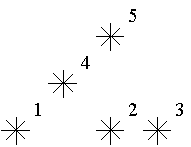Description
Astronomers often examine star maps where stars are represented by points on a plane and each star has Cartesian coordinates. Let the level of a star be an amount of the stars that are not higher and not to the right of the given star. Astronomers want to know the distribution of the levels of the stars.

For example, look at the map shown on the figure above. Level of the star number 5 is equal to 3 (it's formed by three stars with a numbers 1, 2 and 4). And the levels of the stars numbered by 2 and 4 are 1. At this map there are only one star of the level 0, two stars of the level 1, one star of the level 2, and one star of the level 3.
You are to write a program that will count the amounts of the stars of each level on a given map.

For example, look at the map shown on the figure above. Level of the star number 5 is equal to 3 (it's formed by three stars with a numbers 1, 2 and 4). And the levels of the stars numbered by 2 and 4 are 1. At this map there are only one star of the level 0, two stars of the level 1, one star of the level 2, and one star of the level 3.
You are to write a program that will count the amounts of the stars of each level on a given map.
Input
The first line of the input file contains a number of stars N (1<=N<=15000). The following N lines describe coordinates of stars (two integers X and Y per line separated by a space, 0<=X,Y<=32000). There can be only one star at one point of the plane. Stars are listed in ascending order of Y coordinate. Stars with equal Y coordinates are listed in ascending order of X coordinate.
Output
The output should contain N lines, one number per line. The first line contains amount of stars of the level 0, the second does amount of stars of the level 1 and so on, the last line contains amount of stars of the level N-1.
Sample Input
5 1 1 5 1 7 1 3 3 5 5
Sample Output
1 2 1 1 0
Hint
This problem has huge input data,use scanf() instead of cin to read data to avoid time limit exceed.
Source
给出n个星星的坐标 坐标按照y升序,y相同x升序的顺序给出 每个星星的level值为 它左下角 左边 下边星星的个数求各个level值(0 ~ n-1)的星星个数由于y轴已经排好序,可以按照x坐标建立一维树状数组树状数组做的方便 注:此题的x坐标可以为0,而树状数组是从1开始的,所以处理的时候对每个x坐标+1。直接把横坐标的值当做 数状数组那个图上的 第几个点
#include <iostream>
#include <algorithm>
#include <cstdio>
#include <cstring>
#include <queue>
#include <vector>
#include <cmath>
#include <stack>
#include <string>
#include <map>
#include <set>
#define pi acos(-1)
#define LL long long
#define ULL unsigned long long
#define INF 0x3f3f3f3f
#define lson l,mid,rt<<1
#define rson mid+1,r,rt<<1|1
using namespace std;
typedef pair<int, int> P;
const int maxn = 1e5 + 5;
const int N = 32005;
// 直接把横坐标的值当做 数状数组那个图上的 第几个点
int cnt[N], C[N];
int lowbit(int x)
{
return x & (-x);
}
void Update(int x, int k)
{
while (x <= N){
C[x] += k;
x += lowbit(x);
}
}
int Sum(int x)
{
int res = 0;
while (x){
res += C[x];
x -= lowbit(x);
}
return res;
}
int main(void)
{
// freopen("C:\\Users\\wave\\Desktop\\NULL.exe\\NULL\\in.txt","r", stdin);
int n, i, x, y, level;
while (~scanf("%d", &n))
{
memset(C, 0, sizeof(C));
memset(cnt, 0, sizeof(cnt));
for (i = 1; i <= n; i++){
scanf("%d %d", &x, &y);
level = Sum(x+1);
cnt[level]++;
Update(x+1, 1);
}
for (i = 0; i < n; i++)
printf("%d\n", cnt[i]);
}
return 0;
}






















 327
327

 被折叠的 条评论
为什么被折叠?
被折叠的 条评论
为什么被折叠?








